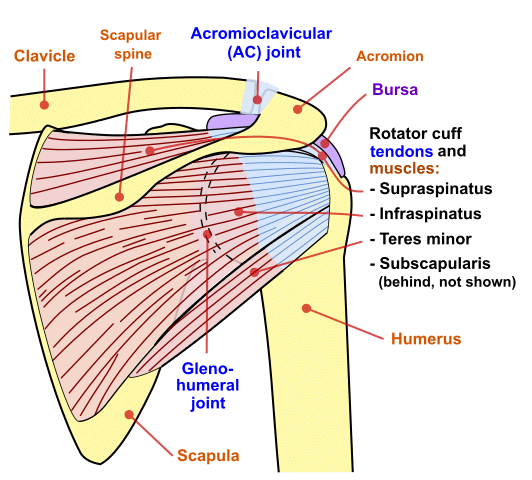Nic Civale is a Doctor of Physical Therapy and former NCAA Division I Baseball player. He combines his knowledge of anatomy and physiology with that of baseball mechanics to provide expectations for injured players. Utilize The MLB Injury Report to make the most of your fantasy season.
What?! Your league didn’t use Fantrax for the 2021 fantasy baseball season? Compare how we match up to the competition and see why you should move your league over in 2022.
The Rotator Cuff: Anatomy
The rotator cuff is something baseball analysts often discuss or mention, but rarely is the time given to properly explain what the structure is and how it relates to overhead throwing. The structure is actually four structures; four muscles that exist around the shoulder and make their final attachment to the humerus bone. These muscles, supraspinatus, infraspinatus, subscapularis, and teres minor, all have major roles to play in the act of throwing. Identifying these muscles is easier than it sounds initially. There is a ridge, or ‘spine’ in your scapula (shoulder blade); above it is the supraspinatus, and below is the infraspinatus. The subscapularis is sub- or below- the scapula itself and lies between the scapula and the ribcage. The teres minor doesn’t have as easy of a roadmap to find its location, but it is just inferior (or below) to the infraspinatus.
Two muscles control what is called external rotation; the infraspinatus and the teres minor. External rotation is easiest to describe as the position the shoulder is in when a referee signifies a field goal is good. A 90-degree angle is made at the elbow, and the shoulders rotation away from the center of the body, or up. Now picture a pitcher in his wind up when his or her arm is in the lay back position and striding towards the catcher. Specifically when the wrist stays back on the second base side of the mound while the elbow is leading the way towards home plate.
Baseball Specific Implications
When a baseball player, or any overhead athlete, injures one of these four muscles, it is common for them to experience significant pain during the throwing motion, and often times develop unwanted mechanical compensations. Pitching coaches, physical therapists, trainers, and motion analysis experts look at game-by-game pitching information to try and detect these changes in the early stages to avoid exacerbating an injury.
Two muscles, the infraspinatus and teres minor, produce external rotation of the shoulder when they are contracted. You need active external rotation to initially cock-back the arm into what many call the lay back position, and to slow the arm down after the release of the ball. Internal rotation is needed to accelerate the arm forward in the phase of throwing that exists between these two times. So in the matter of a split second, the shoulder must produce significant external rotation, followed by explosive internal rotation, followed by precise and substantial external rotation to slow the arm down. The fourth rotator cuff muscle, the supraspinatus is working the entire time, supporting the shoulder joint, and assisting with the motion of elevating the shoulder. It helps the pitcher control arm slot and maintain this throughout the pitching potion.
Based on the heavy demand on the rotator cuff during the throwing motion, it may be easy to see why so many pitchers experience these types of injuries during the season. With all that responsibility during the throwing motion, these muscles need to be constantly cared for, and supported by the surrounding musculature in the area. Following a strain of a rotator cuff muscle, throwing is usually shut down temporarily to assess damage. MRIs and CT scans are run to detect soft tissue (muscle/tendon/ligament) damage and radiographs (X-Rays) are run to detect any possible bone impairment or injury.
Shane Bieber and Pablo Lopez
This past season, two big names experienced rotator cuff injuries; Shane Bieber and Pablo Lopez. There were more specifics reported about Shane Bieber’s injury since we know it was his subscapularis that he strained. Pablo Lopez’s injury was given no specific location as far as I could tell.
Shane Bieber hit the IL in June while Pablo Lopez followed him in July. They returned to Major League mounds in late September and early October respectively, totaling about three months on the shelf each. This sounds like a timetable for a Grade II strain, which is of moderate severity. Bieber’s subscapularis strain limited him in a few substantial ways. The initial lay back position described earlier was probably very painful. The positioning of the arm in this state is at or near full stretch for the subscapularis. On top of being fully stretched out, the muscle then needs to aggressively contract to create the proper force to deliver the ball towards home plate. Finally, the muscle needs to help stabilize the shoulder joint during the follow-through phase, helping to maintain the congruency of the ball and socket joint. Having suffered a less severe Grade I subscapularis strain this past fall, I can confirm that you feel every bit of that painful stretch in the layback and acceleration phase.
Rotator Cuff Rehab
Rehab for Bieber and Lopez is based on what their shoulders allow them to do at a pain-free level. Every body and every muscle heals differently based on nutrition, previous injury, and rest, along with treatment plans. Lopez has experienced previous shoulder issues, but we can’t speculate on their relevance because it is unclear which muscle was injured this time around. Physical therapists and team strength coaches will continue to work with these pitchers on scapular stability and mobility to provide the shoulder joint with as much support and freedom of movement as possible. Strength training would have followed once they could achieve a full range of motion without pain.
Rehab Specifics
Another under-appreciated transition is the progression from flat ground bullpens (“arm barns?”) to mound sessions. The angle at which the body moves is different and actually requires more stretch and muscle activation from the subscapularis in particular. I would not be surprised if Lopez did have a subscapularis strain similar to Bieber’s because his setbacks/halted progressions in rehab came after live innings. In other words, it is possible the transition to the mound put an additional strain on the subscapularis, which alerted Lopez and the rehab staff to be more conservative with his return.
2022 Expectations
With both athletes, it is safe to assume they will be ready to go for 2022 Opening Day. I have no problem drafting either of these two in the same, or similar range they were taken last year, and won’t be discouraged based on these injuries. Remember; in-season injury return is tremendously different than off-season. There is less pressure to come back quicker, especially in arbitration-eligible seasons, when you have the entire offseason to return to full health. You also can spend more time with personal physical therapists if you chose, sleep in your own bed, and be in a less stressful environment. I’m anticipating a nice bounce-back season from Bieber, and a continuation of the breakout campaign Lopez was putting together in 2021. Similar to the advice on Tatis from the last Injury Report piece, take the injury discount!
Check out Eric Cross’s latest piece on the World Series winning Atlanta Braves’ dynasty outlook!
Fantrax was one of the fastest-growing fantasy sites of 2020, and we’re not stopping now. With multi-team trades, designated commissioner/league managers, and drag/drop easy click methods, Fantrax is sure to excite the serious fantasy sports fan – sign up now for a free year at Fantrax.com.



